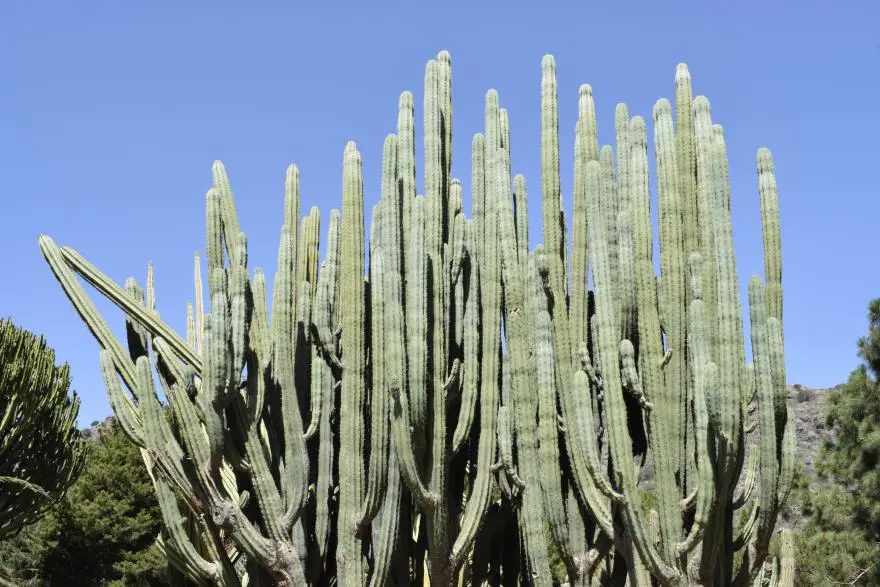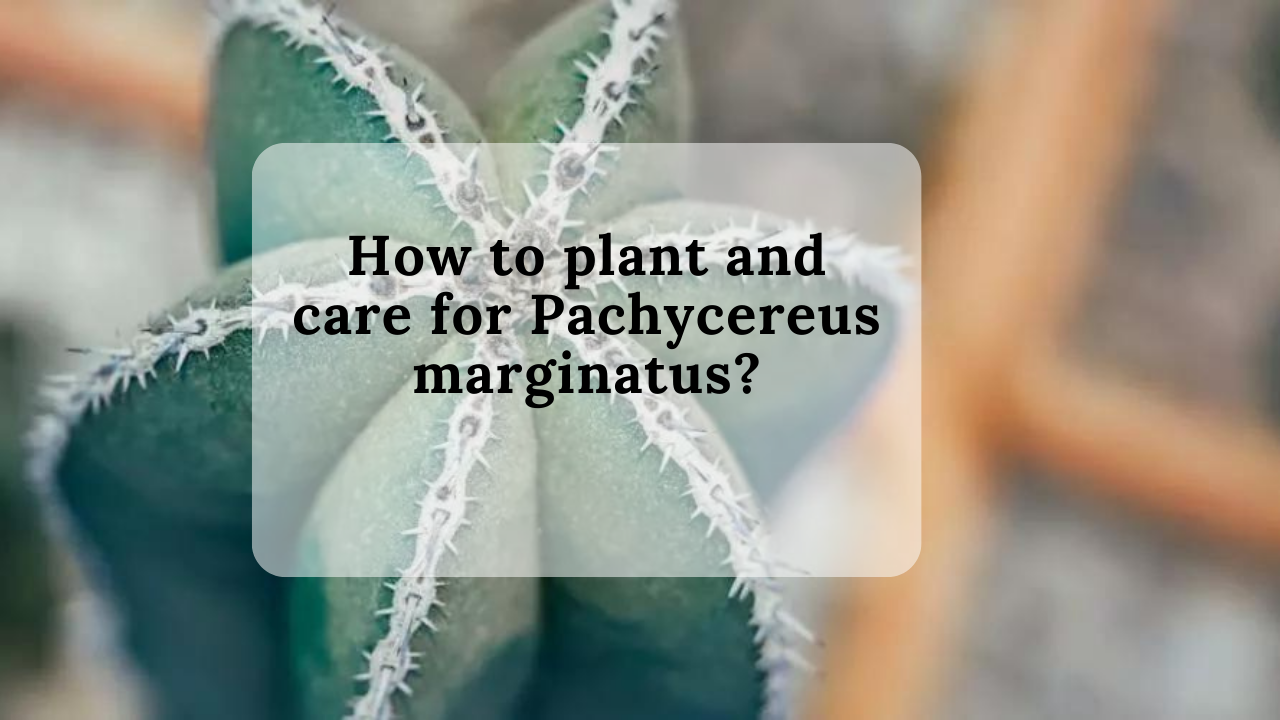Tips and tricks for planting and caring for Pachycereus marginatus
This large candle cactus with 5 or 6 ribs is recognizable by its slightly spiny white margins. Offering daytime summer flowers of a pretty white marbled with red, it does not go unnoticed in the garden!
How to plant and care for Pachycereus marginatus?
Origins and characteristics of Pachycereus marginatus
Type : cacti
Origin : Mexico
Height : 2 to 4 meters
Desired exposure : full sun
Soil type : well drained
Flowering : summer
Flower colors : white, red
Foliage : evergreen
Vegetation : perennial
Hardiness : up to -5°C
Varieties : Pachycereus pecten-aboriginum, Pachycereus pringlei, Pachycereus schottii, Pachycereus grandis, Pachycereus gatesii…
Pachycereus marginatus is a species of cactus in the genus Pachycereus belonging to the Cactaceae family , native to Mexico.
It is a cactus with a columnar habit bearing 5 or 6 ribs whose crests are covered with gray spines. Rapidly growing, the plant measures on average 2 to 4 meters high, but it can reach 7 meters in height in its natural environment.
The flowering of Pachycereus marginatus is diurnal and takes place in summer. The flowers are conical, reddish or white tinged with red on the outside with bristles and fine thorns. The spines are generally short and brownish in color.
The fruit of the cactus is globose and warty. It has the particularity of being covered with thorns and bristles which later fall off.
Some species of Pachycereus marginatus
Here are some species of the Pachycereus genus:
- Pachycereus pringlei (Cardón): Also known as Cardón, this is the largest cactus of the genus. He is originally from Mexico.
- Pachycereus schottii (Mexican Giant Cardon): Another large cactus of the genus, native to Mexico and the southwestern United States.
- Pachycereus marginatus (Mexican Fencepost Cactus): As mentioned previously, this is a species with a thin, straight trunk, native to Mexico.
- Pachycereus weberi: Cactus native to Mexico.
- Pachycereus fulviceps: Native to Mexico, it has a slender appearance and can reach considerable height.
Planting Pachycereus marginatus
– Plant Pachycereus marginatus in the ground :
In the warmer regions of France, you can plant Pachycereus marginatus in the ground. Install it in a sunny location (it does not fear heat or direct sun), in well-drained soil, with sand added, if necessary.
– Plant Pachycereus marginatus in a pot :
Everywhere else, you can plant the cactus in a pot in a substrate composed of 3/4 potting soil and 1/4 topsoil. A special cacti soil is perfect for it. Don’t forget to place clay balls in the bottom of the pot to improve drainage. Place the pot in a very bright room, in full sun. In the summer, don’t hesitate to install your cactus outside, on your terrace or balcony.
Care of Pachycereus marginatus
In the ground, Pachycereus marginatus does not need to be watered! In pots, moderate but regular watering, approximately every ten days, should be expected during spring and summer. Stop watering in fall and winter.
Pachycereus marginatus is capable of withstanding negative temperatures of around -5°C in winter, if the soil remains dry. However, during the cold season, it is preferable to expose it to a temperature above 7°C indoors. If the winter temperature permits, the cactus can remain outside in the ground all year round. You just need to ensure that the soil remains well drained and dry.
Like almost all other cacti , Pachycereus marginatus is repotted every 3 years on average, in spring.

Multiplication of Pachycereus marginatus
Like many cacti, it can be propagated in several ways. Common propagation methods include seed, cutting and offset.
Here is how you can proceed with these methods :
- Sowing:
- Collect seeds from mature fruits of Pachycereus marginatus.
- Plant the seeds in a well-draining, slightly moist substrate.
- Place the seedling tray in a bright location, but avoid intense direct sunlight.
- The seeds should germinate within a few weeks to a few months.
- Cuttings:
- Take a healthy stem from the mother plant using clean, sharp tools.
- Let the cutting dry for a few days to allow the cut to heal.
- Plant the cutting in a well-draining substrate, burying the stem in the soil to an appropriate depth.
- Water lightly and place the cutting in a bright location, but avoid direct sunlight for a while.
- Offsets (rejects):
- Some cacti, including Pachycereus marginatus, produce suckers at the base of the main plant.
- Wait for the offsets to reach a reasonable size.
- Carefully detach the offset from the mother plant using clean tools.
- Let the cut dry for a few days.
- Plant the offset in a well-draining substrate and follow the same steps as for cuttings.
Companion plants of Pachycereus marginatus
- Succulents:
- Agave spp. : Agaves have a similar appearance and comparable growing needs.
- Echeveria spp. : These small succulents can complement the aesthetic of Pachycereus marginatus.
- Companion cacti:
- Ferocactus spp. : Other cacti, such as Ferocactus, can create a harmonious ensemble in a cactus garden.
- Opuntia spp. : Cacti of the Opuntia genus, also known as prickly pears, can be good companions.
- Rockery plants:
- Sedum spp. : Sedums, also known as stonecrops, are hardy plants that can adapt well to a cactus garden.
- Delosperma spp. : These plants, also called icicles, are succulent ground covers that can add color.
- Plants adapted to arid climate:
- Yucca spp. : Yuccas can complement the look of Pachycereus marginatus and are adapted to dry climates.
- Dasylirion spp. : Plants of the Dasylirion genus, such as Dasylirion wheeleri, can fit well into a cactus garden.
- Low maintenance plants:
- Agave parryi: Another species of agave that can pair well with Pachycereus marginatus.
- Aloe spp. : Aloe plants add a tropical touch and are generally easy to care for.
Diseases and pests of Pachycereus marginatus
Diseases :
- Root rot : Soft roots, discoloration, wilting. Make sure the soil drains well and avoid excessive watering. You can try replanting in a drier substrate.
- Stem rot (black stem rot): Black spots on stems, softening. Make sure the plant is well ventilated and avoid excess humidity. Remove the affected parts.
Pests :
- Mealybugs : Small white or brown growths on stems. Remove mealybugs by hand or with a cotton swab dipped in alcohol. Natural predators, such as ladybugs, can also help.
- Mites: Fine webs on leaves, yellow foliage. Rinse the plant with water to remove mites. Applying neem oil can also be helpful.
- Aphids : Deformed, slimy foliage. Rinse the aphids with soapy water or use natural predators like ladybugs.
- Slugs and snails: Bitten leaves. Use physical barriers, such as wood ash, to prevent access. Natural solutions like coffee grounds can also deter them.
General tips for prevention :
- Watering: Avoid excess humidity and make sure the soil drains well.
- Sun Exposure: Make sure the Pachycereus marginatus receives the appropriate amount of sunlight as it needs.
- Ventilation: Make sure air circulates well around the plant to avoid humidity-related problems.
- Cleaning: Regularly remove debris and dead leaves around the plant to prevent the proliferation of pests.
Uses of Pachycereus marginatus
Cactus Gardens: Due to its elegant form and growing characteristics, Pachycereus marginatus is often used in cactus gardens to create attractive, desert landscapes.
Pots and Containers: Due to its relatively manageable size and vertical growth, it is suitable for growing in pots, making it ideal for patios, balconies and decks.
Xerophytic landscaping: It is well suited to landscaping requiring plants adapted to arid and low maintenance conditions.
Soil fixation: The roots of Pachycereus marginatus help prevent soil erosion, which can be beneficial in areas where soil is likely to be carried away by winds or rainwater.

